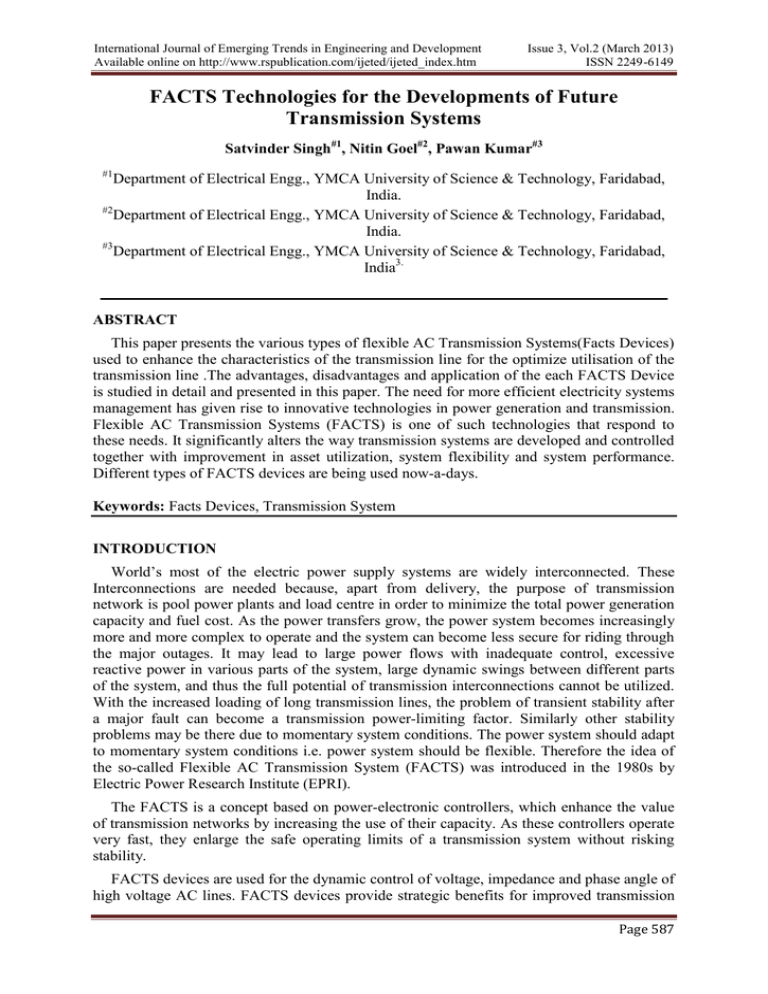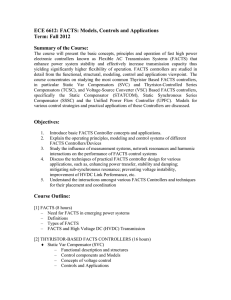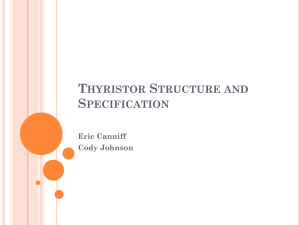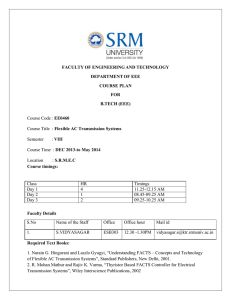FULL TEXT - RS Publication
advertisement

International Journal of Emerging Trends in Engineering and Development Available online on http://www.rspublication.com/ijeted/ijeted_index.htm Issue 3, Vol.2 (March 2013) ISSN 2249-6149 FACTS Technologies for the Developments of Future Transmission Systems Satvinder Singh#1, Nitin Goel#2, Pawan Kumar#3 #1 Department of Electrical Engg., YMCA University of Science & Technology, Faridabad, India. #2 Department of Electrical Engg., YMCA University of Science & Technology, Faridabad, India. #3 Department of Electrical Engg., YMCA University of Science & Technology, Faridabad, India3. ABSTRACT This paper presents the various types of flexible AC Transmission Systems(Facts Devices) used to enhance the characteristics of the transmission line for the optimize utilisation of the transmission line .The advantages, disadvantages and application of the each FACTS Device is studied in detail and presented in this paper. The need for more efficient electricity systems management has given rise to innovative technologies in power generation and transmission. Flexible AC Transmission Systems (FACTS) is one of such technologies that respond to these needs. It significantly alters the way transmission systems are developed and controlled together with improvement in asset utilization, system flexibility and system performance. Different types of FACTS devices are being used now-a-days. Keywords: Facts Devices, Transmission System INTRODUCTION World’s most of the electric power supply systems are widely interconnected. These Interconnections are needed because, apart from delivery, the purpose of transmission network is pool power plants and load centre in order to minimize the total power generation capacity and fuel cost. As the power transfers grow, the power system becomes increasingly more and more complex to operate and the system can become less secure for riding through the major outages. It may lead to large power flows with inadequate control, excessive reactive power in various parts of the system, large dynamic swings between different parts of the system, and thus the full potential of transmission interconnections cannot be utilized. With the increased loading of long transmission lines, the problem of transient stability after a major fault can become a transmission power-limiting factor. Similarly other stability problems may be there due to momentary system conditions. The power system should adapt to momentary system conditions i.e. power system should be flexible. Therefore the idea of the so-called Flexible AC Transmission System (FACTS) was introduced in the 1980s by Electric Power Research Institute (EPRI). The FACTS is a concept based on power-electronic controllers, which enhance the value of transmission networks by increasing the use of their capacity. As these controllers operate very fast, they enlarge the safe operating limits of a transmission system without risking stability. FACTS devices are used for the dynamic control of voltage, impedance and phase angle of high voltage AC lines. FACTS devices provide strategic benefits for improved transmission Page 587 International Journal of Emerging Trends in Engineering and Development Available online on http://www.rspublication.com/ijeted/ijeted_index.htm Issue 3, Vol.2 (March 2013) ISSN 2249-6149 system management through better utilization of existing transmission assets, increased transmission system reliability and availability, increased dynamic and transient grid stability, increased quality of supply for sensitive industries (e.g. computer chip manufacture), and enabling environmental benefits. Typically the construction period for a FACTS device is 12 to 18 months from contract signing through commissioning. The FACTS technology is essential to alleviate some but not all of these difficulties by enabling utilities to get the maximum performance from their transmission facilities and enhance grid reliability. FACTS technology opens up new opportunities for controlling power and enhancing the usable capacity of present, as well as new and upgraded lines. The possibility that the current through a line can be controlled at a reasonable cost enables a large potential of increasing the capacity of existing lines with larger conductors, and use of one of the FACTS controller to enable corresponding power to flow through such lines under normal and contingency conditions. [5]. In the family of FACTS controllers, there are a few controllers, viz STATCOM, TCSC and UPFC that have potent application in India. Here STATCOM will have application right from distribution voltage to EHV level, while TCSC will be specifically applied in those locations where plain series compensation has not been dynamic enough to control the power flow or maintain the voltage profile and provide positive damping in the dynamic condition. In India, there are several locations where TCSC could be effectively applied, but its overall advantage has to be worked out after the system has been provided with first series compensation. According to IEEE Definitions and Terms [5] Flexibility of Electric Power Transmission is “The ability to accommodate the changes in the electric transmission system or operating conditions while maintaining sufficient steady-state and transient margins.” Flexible AC Transmission System (FACTS) is “Alternating current transmission systems incorporating power electronic-based and other static-controllers to enhance controllability and increase power transfer capability.” FACTS Controller is “A power electronic-based system and other static equipment that provide control of one or more AC transmission system parameters.” BENEFITS OF FACTS DEVICES (i) (ii) (iii) (iv) (v) (vi) (vii) (viii) (ix) Control of power flow as ordered. The use of control of the power flow may be to follow a contract, meet the utilities own needs, ensure optimum power flow, ride through emergency conditions, or a combination thereof. Increasing the loading capability of lines to their thermal capabilities, including short term and seasonal. Increasing the system security through raising the transient stability limit, limiting short circuit currents and overloads, managing cascading black outs and damping electromechanical oscillations of power systems and machines. Providing secure tie line connections to neighbouring utilities and regions thereby decreasing overall generation reserve requirements on both sides. Providing greater flexibility in siting new generation. Up gradation of lines. Reduction in reactive power flows, thus allowing the lines to carry more active power. Reduction in loop flows. Increasing utilization of lowest cost generation. Because the voltage, current, impedance, real power, and reactive power are interrelated, each controller has multiple attributes of what they can do in terms of controlling the voltage, power flow, stability and so on. Page 588 International Journal of Emerging Trends in Engineering and Development Available online on http://www.rspublication.com/ijeted/ijeted_index.htm Issue 3, Vol.2 (March 2013) ISSN 2249-6149 FACTS DEVICES The FACTS devices have been mainly classified as follows: i. Series Controllers ii. Shunt Controllers iii. Combined Series-Series Controllers iv. Combined Series-Shunt Controllers Series Controllers: The series controllers may be variable impedance, such as capacitor, reactor etc. or power electronics based variable source of main frequency, sub synchronous and the harmonic frequencies or a combination to serve the desired need. In principle, all series controllers inject voltage in series with the line. As long as the voltage is in phase quadrature with the line current, the series controller only supplies or consumes variable reactive power. Any other phase relationship will involve handling of real power as well. The detailed classification of series controllers is as following: (a) (b) (c) (d) (e) Thyristor Controlled Series Capacitor (TCSC) Static Synchronous Series Compensator (SSSC) Thyristor Switched Series Capacitor (TSSC) Thyristor Controlled Series Reactor (TCSR) Thyristor Switched Series Reactor (TSSR) Various series connected controllers are discussed in brief as following: Thyristor Controlled Series Capacitor (TCSC) TCSC is a capacitive reactance compensator which consists of a series capacitor bank shunted by a thyristor-controlled reactor in order to provide a smoothly variable series capacitive reactance. The TCSC is based on thyristor without the gate turn-off capability. A variable reactor such as Thyristor Controlled Reactor (TCR) is connected across a series capacitor. Fig 1 Schematic diagram of TCSC Depending on the TCR firing angle, the capacitive impedance is varied. The TCSC may be single large unit or may consist of several equal or different-sized smaller capacitors in order to achieve a superior performance. Static Synchronous Series Compensator (SSSC) SSSC consists of a static synchronous generator, operated without an external electric energy source as a series compensator whose output voltage is in quadrature with, and controllable independently of, the line current for the purpose of increasing or decreasing the overall reactive voltage drop across the line and thereby controlling the transmitted electric power. The SSSC may include transiently rated energy storage or energy absorbing devices to enhance the dynamic behaviour of the power system by additional temporary real power Page 589 International Journal of Emerging Trends in Engineering and Development Available online on http://www.rspublication.com/ijeted/ijeted_index.htm Issue 3, Vol.2 (March 2013) ISSN 2249-6149 compensation, to increase or decrease momentarily, the overall real (resistive) voltage drop across the line. Fig.2 Schematic diagram of SSSC Thyristor Switched Series Capacitor (TSSC) TSSC is a capacitive reactance compensator which consists of a series capacitor bank shunted by a thyristor-switched reactor to provide a stepwise control of series capacitive reactance. Instead of continuous control of capacitive impedance, this approach of switching inductors at firing angle of 90 degrees or 180 degrees but without firing angle control could reduce cost and losses of the controller. It is reasonable to arrange one of the modules to have thyristor control, while others could be thyristor switched. Fig.3 Schematic diagram of TSSC Thyristor-Controlled Series Reactor (TCSR) TCSR is an inductive reactance compensator which consists of a series reactor shunted by a thyristor TCSR is an inductive reactance compensator which consists of a series reactor shunted by a thyristor controlled reactor in order to provide a smoothly variable series inductive reactance. When the firing angle of the thyristor controlled reactor is 180 degrees, it stops conducting, and the uncontrolled reactor acts as a fault current limiter. As the angle decreases below 180 degrees, the net inductance decreases until firing angle of 90 degrees, when the net inductance is the parallel combination of the two reactors. As in TCSC, the TCSR may be a single large unit or several smaller series units. Fig.4 Schematic diagram of TCSR Page 590 International Journal of Emerging Trends in Engineering and Development Available online on http://www.rspublication.com/ijeted/ijeted_index.htm Issue 3, Vol.2 (March 2013) ISSN 2249-6149 Thyristor-Switched Series Reactor (TSSR) TSSR is an inductive reactance compensator which consists of a series reactor shunted by a thyristor-controlled switched reactor in order to provide a stepwise control of series inductive reactance. This is complement of TCSR, but with thyristor switches fully on or fully off to achieve a combination of stepped series inductance. Shunt Controllers: These may be variable impedance, variable source, or a combination of these. In principle, all shunt controllers inject current into the system at the point of connection. Even variable shunt impedance connected to the line voltage source causes a variable current flow and hence represents injection of current into the line. As long as the injected current is in phase quadrature with the line voltage; the shunt controller only supplies or consumes variable reactive power. Any other phase relationship will involve handling of real power as well. The classification of shunt controllers is as following: (a) Static Var Compensator (SVC) (b) Static Synchronous Compensator (STATCOM) (c) Static Synchronous Generator (SSG) (d) Thyristor Controlled Reactor (TCR) (e) Thyristor Switched Reactor (TSR) Various shunt connected controllers are discussed in brief as following: Fig.5: Schematic diagram of a line with Static VAR Compensator (SVC), Static VAR Generator (SVG), Static VAR System (SVS), Thyristor Controlled Reactor (TCR), Thyristor Switched Capacitor (TSC), and Thyristor Switched Reactor (TSR) [5] Static Var Compensator (SVC) SVC is “A shunt-connected static var generator or absorber whose output is adjusted to exchange capacitive or inductive current so as to maintain or control specific parameters of the electrical power system.” Static Synchronous Compensator (STATCOM) STATCOM is a static synchronous generator operated as a shunt connected static var compensator whose capacitive or inductive output current can be controlled independent of Page 591 International Journal of Emerging Trends in Engineering and Development Available online on http://www.rspublication.com/ijeted/ijeted_index.htm Issue 3, Vol.2 (March 2013) ISSN 2249-6149 the A.C. system voltage. STATCOM is one of the key FACTS controllers. It may be based on a voltage- sourced or current-sourced converter. Fig.6 Schematic diagram of STATCOM According to IEEE Static Synchronous Generator (SSG) is “A static self-commutated switching power converter supplied from an appropriate electric energy source and operated to produce a set of adjustable multiphase output voltages, which may be coupled to an A.C. power system for the purpose of exchanging independently controllable real and reactive power .” Static Synchronous Generator (SSG) SSG is a static self-commutated switching power converter supplied from an appropriate electric energy source and operated to produce a set of adjustable multiphase output voltages, which may be coupled to an ac power system for the purpose of exchanging independently controllable real and reactive power. SSG is a combination of STATCOM and any energy source to supply or absorb power. Thyristor Controlled Reactor (TCR) TCR is a subset of SVC, in which conduction time and hence, current in a shunt reactor is controlled by a thyristor based A.C. switch with firing angle control. TCR is “A shunt connected, thyristor controlled inductor whose effective reactance is varied in a continuous manner by partial conduction control of the thyristor valve.” The schematic diagram of TCR is as shown in Fig.7 showing symbolic representations of its parts. Fig.7 Schematic diagram of TCR Page 592 International Journal of Emerging Trends in Engineering and Development Available online on http://www.rspublication.com/ijeted/ijeted_index.htm Issue 3, Vol.2 (March 2013) ISSN 2249-6149 Thyristor Switched Reactor (TSR) TSR is also subset of SVC and is “A shunt-connected, thyristor-switched inductor whose effective reactance is varied in a stepwise manner by full or zero conduction operation of thyristor valve.” Thyristor Switched Capacitor (TSC) TSR is also subset of SVC and is “A shunt-connected, thyristor-switched capacitor whose effective reactance is varied in a stepwise manner by full or zero conduction operation of thyristor valve.” The schematic diagram of TSC is as shown in Fig.8 showing symbolic representations of its parts. Fig.8 Schematic diagram of TSC Combined Series -Series Controllers: This may be a combination of separate series controllers, which are controlled in a coordinated manner, in a multi-line transmission system. It may be otherwise a unified controller; in which series controllers provide independent series reactive compensation for each line but also transfer real power among the lines via the power link. The real powertransfer capability of the unified series-series controller, referred to as Interline Power Flow Controller, makes it possible to balance both the real and reactive power flow in the lines and thereby maximize the utilization of transmission system. Here the term “unified” means that the D.C terminals of all controller converters are all connected together for real power transfer. Interline Power Flow Controller is the main combined series -series controller. Interline Power Flow Controller (IPFC) IPFC is recently introduced controller and is “The combination of two or more Static Synchronous Series Compensators which are coupled via a common D.C link to facilitate bidirectional flow of real power between the A.C terminals of the SSSC, and are controlled to provide independent reactive compensation for the adjustment of real power flow in each line and maintain the desired distribution of reactive power flow among the lines.” Page 593 International Journal of Emerging Trends in Engineering and Development Available online on http://www.rspublication.com/ijeted/ijeted_index.htm Issue 3, Vol.2 (March 2013) ISSN 2249-6149 Combined Series- Shunt Controllers: This may be a combination of separate shunt and series controllers, which are controlled in a coordinated manner or a Unified Power Flow Controller with series and shunt elements. In principle, combined shunt and series controllers inject current into the system with shunt part of controller and voltage with the series part of controller. Also, when the shunt and series controllers are unified; there can be a real power exchange between the series and shunt controllers via the power link. The classification of series-shunt controllers is as following: (a) Unified Power Flow Controller (UPFC) (b) Thyristor Controlled Phase Shifting Transformer (TCPST) (c) Inter-phase Power Controller (IPC) Unified Power Flow Controller Unified Power Flow Controller (UPFC) is “A combination of Static Synchronous Compensator (STATCOM) and a Static Synchronous Series Compensator (SSSC) which are coupled via a common D.C link to allow bi-directional flow of real power between the series output terminals of the SSSC and the shunt output terminals of the STATCOM; and are controlled to provide concurrent real and reactive series line compensation without an external electric energy source.” Fig.9 Schematic diagram of UPFC The UPFC, by means of angularly unconstrained voltage injection, is able to control, concurrently or selectively, the transmission line voltage, impedance and the angle or, alternatively, the real and reactive power flow in the line. The UPFC may also provide independently controllable shunt reactive compensation. The UPFC is a device, which is capable of instantaneous control of three-system parameters transmission line impedance, phase angle and reactive power. From the conceptual viewpoint; the UPFC is a generalized synchronous voltage source; represented at the fundamental power system frequency by a voltage phasor, with controllable magnitude and angle in series with the transmission line. The UPFC consists of two voltage-sourced converters, which operate from a common D.C. Circuit consisting of a storage capacitor. The UPFC could be described as consisting of a parallel and series branch. Each converter can independently generate or absorb reactive Page 594 International Journal of Emerging Trends in Engineering and Development Available online on http://www.rspublication.com/ijeted/ijeted_index.htm Issue 3, Vol.2 (March 2013) ISSN 2249-6149 power. This arrangement enables free flow of active in either direction between the A.C. terminals of the two converters. CONCLUSION In this paper a literature survey on various types of Flexible A.C. Transmission system is presented. A brief about the FACTS device is explained along with standard IEEE definition. Benefits of FACTS devices in the power flow are explained. This paper gives a general idea about the various classifications of the FACTS devices. REFERENCES [1] Acha Enrique, Fuerte-Esquivel, Ambriz-Perez and Angeles-Camacho, FACTS, Modelling and Simulation in Power Networks, John Wiley & Sons Publication, IEEE Press, New York, 2004. [2] Arunachalam M., Lal Ghamandi, CG Rajiv and MM Babu Narayanan, “Performance Verification of TCSC Control and Protection Equipment Using RTDS”, 15th PSCC, Liege, Session 32, Paper 6, pp.1-7, Aug. 2005. [3] Ghosh Arindam, Chatterjee D., Bhandiwad P. and Pai M.A. , “Trajectory Sensitivity Analysis of TCSC Compensated Power System”, IEEE Power Engineering Society General meeting, pp.1454-1459,Denver, June 2004. [4] Grunbaum R. and Pernot Jacques, “Thyristor Controlled Series Compensator: A State of the Art Approach for Optimization of Transmission Over Power Links”, ABB Power Systems, 2001. [5] Hingorani NG and Gyugi L, Understanding FACTS –Concepts and Technology of Flexible Ac Transmission Systems, Standard Publishers Distributors, IEEE Press, New York, 2001. [6] Helbing Scott G. and Karady G.G., “Investigations of an Advanced Form of Series Compensation”, IEEE transactions on Power delivery, vol.9, no.2, pp.939-947, Apr. 1994. [7] Jovcic Dragan and Pillai G.N., “Analytical Modelling of TCSC Dynamics”, IEEE Transactions on Power Delivery, vol.20, no.2, pp. 1097-1104, Apr. 2005. [8] Khederzadeh Mojtaba and SidhunTarlochan S., “Impact of TCSC on the Protection of Transmission Lines”, IEEE Transactions on Power Delivery, vol.21,no.1, pp. 80-87, Jan. 2006. [9] Larsen E.V, Clark K., Miske S.A. and Urbanek J., “Characteristics and Rating Considerations of Thyristor Controlled Series Compensation”, IEEE Transactions on Power Delivery, vol.9, no.2, pp. 992-1000, Apr. 1994. Page 595



